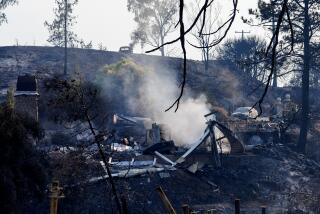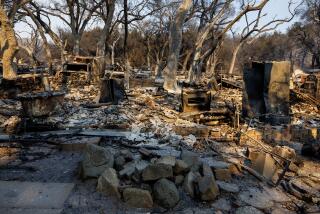Flaws Cited in O.C. Disaster Coordination
Orange County has some of the most sophisticated programs in the country to deal with an earthquake but lacks coordination among county agencies, emergency planners for the county said Tuesday.
Christine Boyd, manager of the county’s Emergency Management Division, said in an interview that her agency, which would coordinate the county’s disaster relief efforts in the event of a severe earthquake, has not been adequately informed of the status of earthquake preparedness programs under way in various county agencies.
Boyd said that finding will be one of the highlights of a report to be presented next week to the County Board of Supervisors. The report was requested by the board after a published report last week that most of a $3-million earthquake preparedness plan approved by the board in 1987 was never implemented by the county administrative officer.
“I think all of this attention is telling us, hey, we have to coordinate better with other offices,” Boyd said. “We have to maintain better touch with the earthquake preparedness programs (under way) by other agencies, and I think that’s going to be one of the focuses of our report next week.”
At Tuesday’s regular meeting of the Board of Supervisors, Chairman Thomas F. Riley said, all of the county’s emergency planning should be re-evaluated in light of the devastation of the Bay Area.
“It’s essential for the Board of Supervisors to evaluate our current capabilities and take whatever steps are necessary to deal with the very real possibility of an earthquake here in Orange County,” said Riley, who called for the preparedness report.
At Tuesday’s meeting, the supervisors were assured that the county has some of the most advanced equipment--and its employees have received some of the most advanced training--in the nation to deal with emergencies, including an earthquake.
The assurances came from Hugh Wood, director of county special services, which oversees emergency planning. Wood cited the rescue vehicle and its crew of four firefighters airlifted to the Bay Area last week that later led the rescue of the last-known survivor in the Nimitz Freeway collapse in Oakland.
Under questioning by Supervisor Gaddi H. Vasquez, Wood also cited the county’s fire and rescue radio communication system as one of the best in the country.
Unlike most jurisdictions that communicate through central dispatchers, every Orange County fire station and police department, as well as all police and rescue vehicles, can talk directly with each other by way of sophisticated radio equipment, noted Vasquez, a former police officer in Orange.
“Both the cities and the county have spent enormous amounts of dollars to improve this state-of-the-art system,” he said.
Supervisor Harriett M. Wieder, however, expressed concern over suggestions that improvement might be needed in coordination among all the agencies involved in dealing with a disaster. Wieder recalled that communication among county departments became a stumbling block for officials trying to cope with severe floods in March, 1983.
“The big problem then was the lack of coordination, and I thought in the last six years there had been some communication plans” developed, Wieder said. “That was our biggest weakness.”
Wood assured the board that interagency communication was vastly improved since then. He said, however, that the county should re-evaluate its links among agencies in the light of problems that have arisen in the Bay Area since last week’s earthquake.
Wood said preliminary reports from the team of four Orange County firefighters and a local observer indicate that communications among state, federal and local agencies have not worked as well as anticipated.
“There was a lack of effective communication” between various levels of government, Wood said. “It didn’t work as the plans said it should.”
More to Read
Sign up for Essential California
The most important California stories and recommendations in your inbox every morning.
You may occasionally receive promotional content from the Los Angeles Times.










